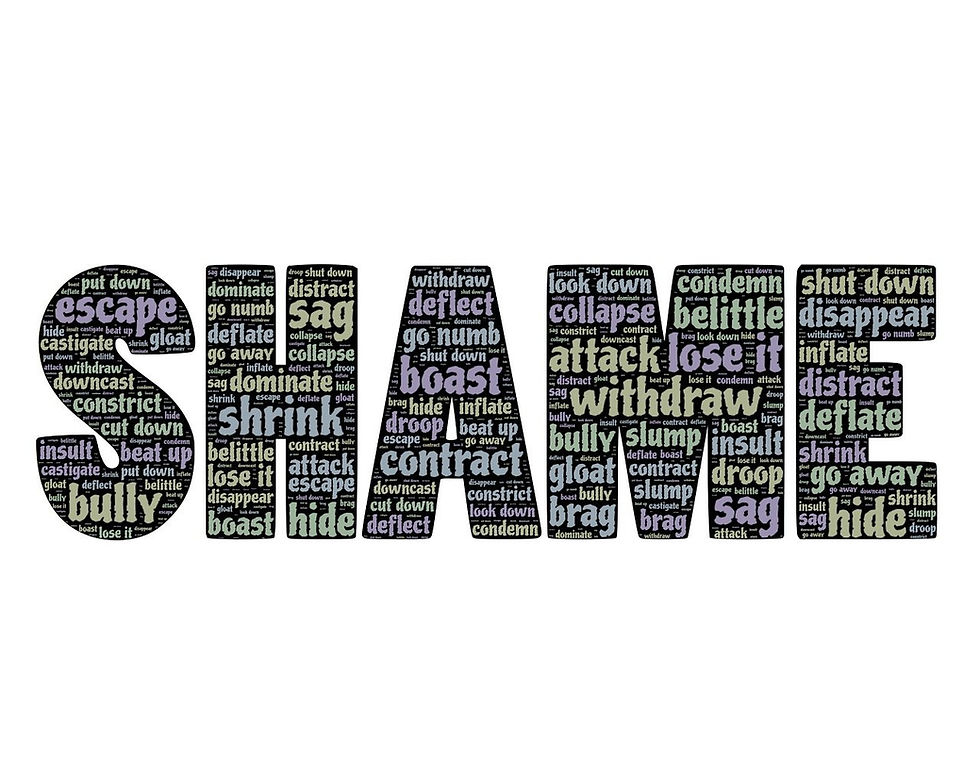The Weight of Shame: How to Acknowledge, Release, and Rebuild
- Dr. Michael Gamble
- Mar 29
- 6 min read
The Heavy Shadow of Shame

Shame is an expert shapeshifter. It slithers into our thoughts, masquerading as self-awareness, accountability, or even motivation. But in reality, shame is a weight—a silent, crushing burden that distorts our self-perception and warps our sense of worth. Unlike guilt, which whispers, "I made a mistake," shame bellows, "I *am* the mistake." Left unchecked, it seeps into our decisions, relationships, and ambitions, dictating the course of our lives in ways we rarely recognize.
So, how do we loosen its grip? How do we shift from self-condemnation to self-compassion? It begins with understanding the roots of shame, learning how to release it, and consciously rebuilding our inner narrative with strength and grace.
The Psychology & Metaphysics of Shame
Shame isn’t just an emotion; it’s a physiological, biochemical, and energetic experience. It triggers the release of cortisol, the body's primary stress hormone, which, when chronically elevated, leads to fatigue, anxiety, and even immune suppression. At the same time, shame can suppress dopamine and serotonin levels, reducing our ability to experience pleasure and motivation.
Neurologically, it activates the same regions of the brain associated with physical pain, reinforcing a cycle of self-criticism and distress. The body remembers shame—our nervous system tenses, our breath shortens, and we shrink inward.

This response is deeply tied to the amygdala, the brain's fear center, which signals the hypothalamic-pituitary-adrenal (HPA) axis to flood the body with stress hormones like cortisol. Over time, repeated activation of this system can lead to heightened anxiety, emotional dysregulation, and even chronic physical ailments. Shame essentially locks the body into a state of hyper-vigilance, reinforcing the very feelings of unworthiness it stems from.
In the metaphysical sense, shame creates energetic blockages, dimming our inner light and disrupting our ability to manifest joy, success, and self-love. Neurologically, it activates the same regions of the brain associated with physical pain. The body remembers shame—our nervous system tenses, our breath shortens, and we shrink inward. In the metaphysical sense, shame creates energetic blockages, dimming our inner light and disrupting our ability to manifest joy, success, and self-love.
Understanding shame through both a psychological and spiritual lens allows us to see it not as an inherent truth, but as a learned response. This realization is the first step toward healing.
The Deep Impact of Shame on the Body and Mind
Shame doesn’t just linger in the mind; it carves deep pathways into our nervous system, influencing everything from digestion to immune response. When we experience chronic shame, the prefrontal cortex—responsible for rational thought and decision-making—becomes less active, while the amygdala and limbic system, responsible for fear and emotional reactions, take control. This shift can make us more reactive, prone to anxiety, and less able to regulate our emotions.
Physiologically, prolonged shame contributes to inflammation, weakens the immune system, and can even alter gut health, leading to digestive issues. Studies show that individuals with chronic shame are more likely to experience autoimmune disorders, cardiovascular problems, and metabolic issues due to the body's prolonged exposure to stress hormones. Understanding these effects is crucial in addressing shame holistically—both mentally and physically.

Breaking the Cycle: Recognizing the Origins of Shame
Shame is often planted in childhood, growing from the messages we received from caregivers, teachers, and society. Whether it was a disapproving look, harsh words, or systemic oppression, these experiences wove the narrative that we are “not enough.” However, shame doesn’t just begin and end with us—it can be generational, passed down through familial behaviors, cultural expectations, and even encoded in our DNA through epigenetics.
Generational Shame, Epigenetics & Genetic Memory
Generational shame is the silent inheritance we rarely acknowledge. Families carry unspoken wounds—secrets, traumas, and cultural stigmas—that shape how emotions are processed and expressed. If a parent was shamed for vulnerability, they may unconsciously teach their child to suppress emotions. If ancestors endured systemic oppression, that shame can become an ingrained survival mechanism, influencing self-worth across generations.

Epigenetics, the study of how environmental factors influence gene expression, provides scientific backing to this phenomenon. Studies have shown that trauma, including the persistent stress associated with shame, can lead to chemical modifications in DNA, which then influence how genes are expressed in future generations. For example, research on Holocaust survivors and their descendants has demonstrated that the trauma endured was linked to changes in stress hormone regulation, making their children more susceptible to anxiety and emotional dysregulation. Research suggests that trauma, including shame-based experiences, can alter gene expression and be passed down to future generations.
This means that the shame you feel may not have started with you—but you have the power to break the cycle. Genetic material is not just a blueprint for physical traits; it also carries markers influenced by ancestral experiences. If previous generations lived under the weight of collective trauma, oppression, or cultural stigmas, those experiences could be passed down not just behaviorally but biologically. Understanding this allows us to approach shame with greater compassion and an awareness that healing ourselves can positively affect future generations.

To dismantle this narrative, we must:
- Identify the source: Whose voice echoes in your mind when shame arises?
- Challenge the validity: Would you speak to a loved one the way you speak to yourself?
- Separate fact from feeling: Shame is an emotional experience, not a reflection of truth.
Techniques to Release Shame: Evidence-Based Approaches
Releasing shame requires both cognitive rewiring and energetic cleansing. Here are some powerful techniques:
1. Cognitive Behavioral Therapy (CBT) & Reframing
CBT is one of the most extensively researched methods for addressing shame. Studies show that CBT helps individuals challenge and replace negative self-perceptions with constructive beliefs. A 2018 study in *Cognitive Therapy and Research* found that cognitive restructuring significantly reduces shame-driven behaviors and improves self-esteem. Keeping a “shame audit” journal allows individuals to track thought patterns, identify distortions, and actively reframe them.
- Challenge negative thoughts and replace them with compassionate truths.
- Keep a “shame audit” journal to track patterns and triggers.
2. Neurolinguistic Programming (NLP)
NLP techniques are rooted in the idea that language shapes thought patterns. Research on NLP-based interventions suggests that using positive affirmations and mental rehearsal can shift deeply ingrained beliefs. A 2021 review in Frontiers in Psychology highlighted the effectiveness of guided visualization and affirmations in reducing negative self-perception, particularly in individuals struggling with self-worth issues.
- Use affirmations that reprogram subconscious beliefs (e.g., “I am worthy of love and acceptance.”)
- Practice visualization exercises where you rewrite past shaming experiences with a new, empowering perspective.
3. Metaphysical & Holistic Practices
- Breathwork & Meditation: Controlled breathing techniques, such as diaphragmatic breathing, have been shown to reduce cortisol levels and activate the parasympathetic nervous system, aiding emotional regulation. A study in *Psychoneuroendocrinology* found that mindfulness meditation significantly reduces self-reported shame and guilt.
- Energy Clearing: Practices like Reiki and Emotional Freedom Technique (EFT) work by addressing stored emotional energy. A 2019 study in *Complementary Therapies in Clinical Practice* found that EFT led to measurable reductions in anxiety and trauma-related symptoms.
- Inner Child Healing: Psychodynamic research suggests that revisiting and reparenting the inner child through guided visualization and affirmations helps in reframing past experiences. A study in *Trauma & Memory* revealed that inner child work can significantly reduce the lingering impact of childhood shame and trauma.
- Breathwork & Meditation: Intentional breathing to release stored shame energy.
- Energy Clearing: Practices like Reiki, sound healing, or EFT (tapping) to shift stagnant shame from the body.
- Inner Child Healing: Reassure your younger self that they are loved and accepted as they are.
Rebuilding with Strength-Based Growth

Comments